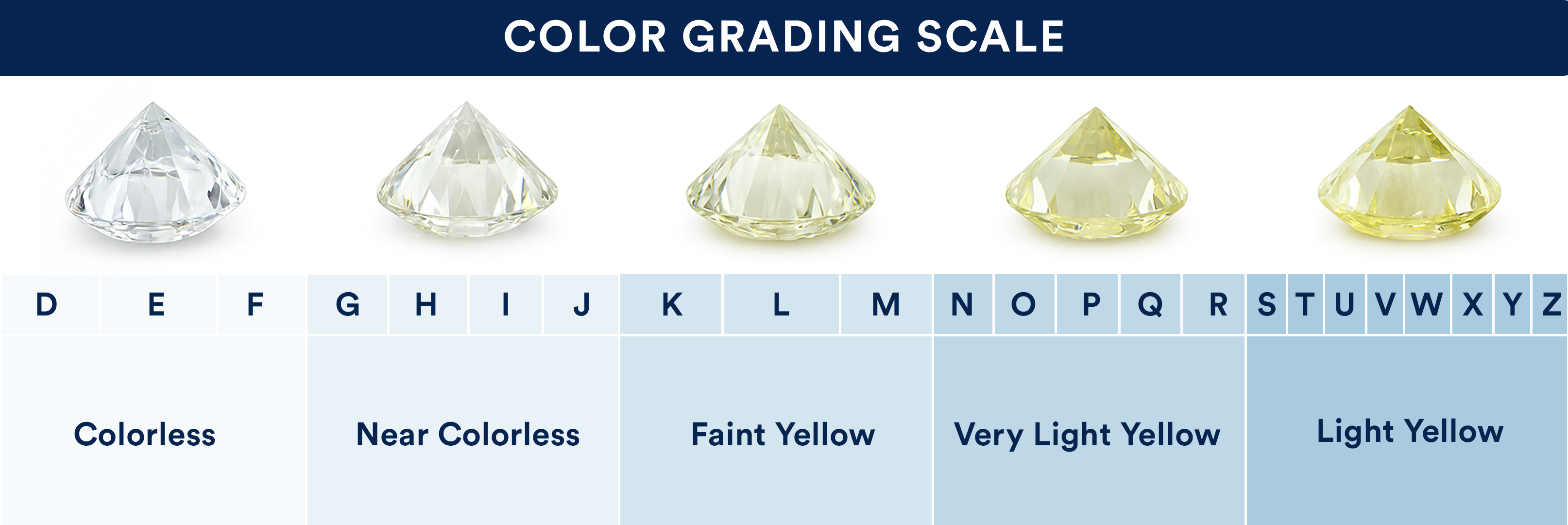Diamond Color Scale Chart | 4C's Education
A comprehensive guide to the art and science of diamond color
- Grades range from D (colorless) to Z (light yellow).
- Diamond color is key to quality and appeal.
- Evaluated under controlled lighting by experts.
- Even slight variations affect brilliance and value.
- Ideal color balances quality, taste, and budget.
Fast Facts on Diamond Color
- Lower color grades of 3-4 grades will not be detectable from higher color grades with an untrained eye.
- Opting for a slightly lower color grade with higher cut or carat weight can save money, but a reminder that color becomes more obvious with a larger diamond.
- Choosing a diamond with a lower color grade set with a contrasting metal ring setting or slightly lower color grade side diamonds can make the center stone appear whiter.
- Some diamond shapes with a low color grade will appear more yellow than round brilliant cut diamonds of the same grade.
What is the Diamond Color Scale?
Let’s learn about diamond color (and we aren't talking about fancy color diamonds here). In order to understand the nuances of diamond color, you must first understand how diamond color is determined. Here is a diamond color scale as a refresher:
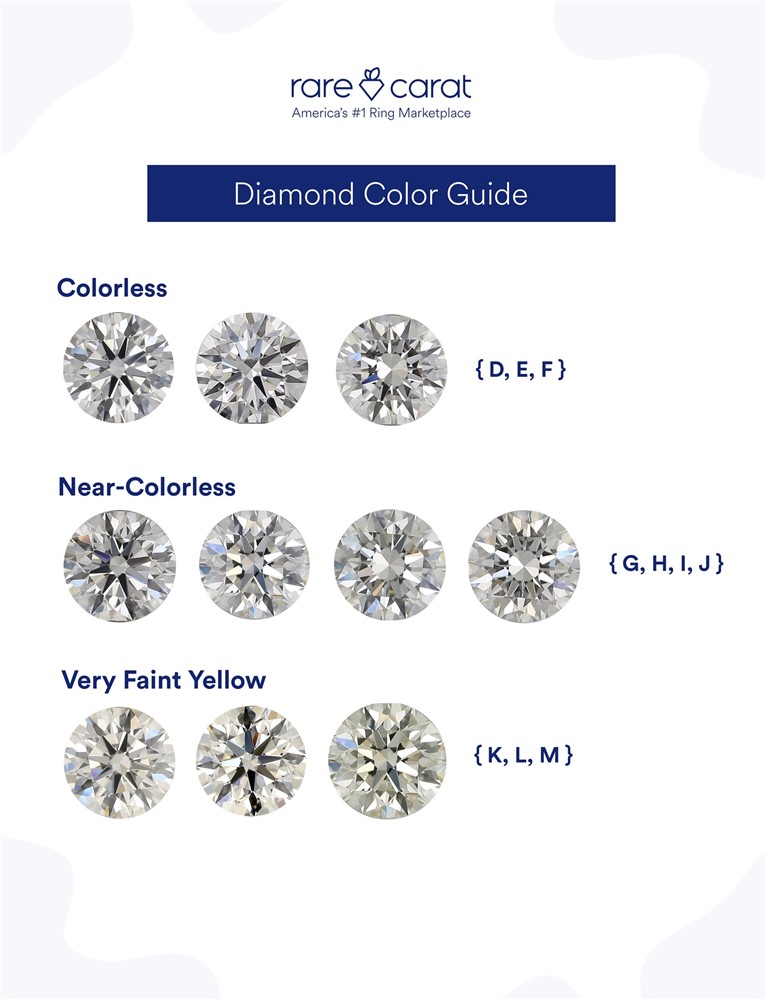
How Diamonds are Graded for Color
Fun fact: Diamonds are graded face down. It allows the grader to accurately assess the color without the interference of the sparkle and brilliance the stone exhibits from the tabletop.
Each loose diamond is not looked at on its own but is compared to a set of ‘master stones’ (usually a set of CZ stones in every color grade). The grader will place the diamond face down on a white surface and then match up that particular stone with the identical colored master stone. It's important to understand that while all diamond colors are graded in the same way, a diamond’s color can actually look very different from the table-top and face-down or side perspectives:
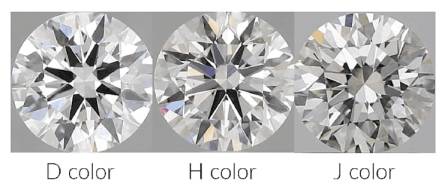
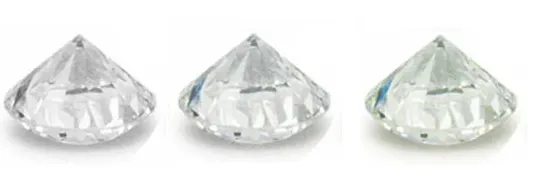
From left to right we have a D, H and J color in the colorless diamond range. As you can see (especially when it comes to the D and H), there is a subtle difference when examined from the table-top position in comparison to face down. This is where your own eye matters the most. You won't be scrutinizing the color of your diamond from a face-down position, because it will most likely be placed in a beautiful ring setting for you and/or your partner to show off.
Secondly, unless you and/your partner plan you carry around a full set of GIA master stones in your pocket to show people the definitive color grade, then you are unlikely to encounter a situation whereby your diamond color will be scrutinized to such a degree. The closest you might get to that scenario is if you choose a diamond wedding band, which can easily be picked so as to enhance the beauty of the engagement ring stone.
The visual difference between a D and an H will only be obvious when held directly next to each other, but the price differential will be substantial.
So, Which Diamond Color is the Best Value for Your Money?
This is completely up to you, but I do have a few nuggets of information that will hopefully help you make a decision that fits you best. Let’s start with the top of the range colorless stones. The cream of the crop. The best of the best. For this range, I’m going to give you the same advice I gave you with regards to clarity - unless there is a specific reason why you really want a colorless stone (which is completely okay), it doesn’t make a huge amount of financial sense to spend extra on the highest color grade diamonds.
Once mounted in a ring setting, those near colorless stones G-J will perform just as well (if not better, depending on the cut) as their colorless comrades.
Lower Color Grades: K-M Pros
Moving on down the scale, we’ve gotten to the K-M colors. These diamonds will have a faint color to them, and if you are color-averse I would suggest staying away from them. If, on the other hand, the notion of a diamond exhibiting a tiny hint of warmth does not have you running for the hills, this might be the color range for you. In fact, I believe these might be the real hidden gems of the diamond color scale. Let’s take a look at a few real-life examples:
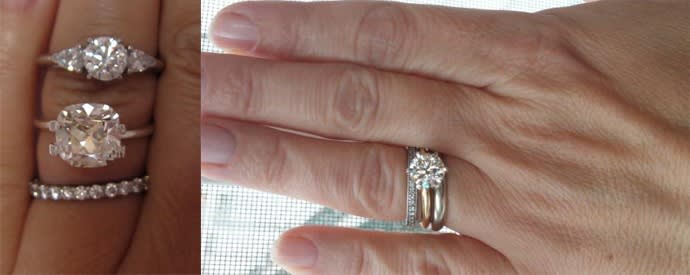
The picture on the left is an ‘M’ color diamond (larger stone) compared to an ‘H’ color three stone ring. Even though you can see a difference color-wise between the two, the ‘M’ color stone still looks lovely. The picture on the right is another ‘M’ colored stone in a yellow gold setting next to white gold bands, and it holds a little secret. The reason why this ‘M’ looks so white is that it’s in a yellow gold setting vs. a white gold setting. On its own the stone might look yellowish - especially face-down - but in the yellow gold band it's contrasting with something darker (as well as picking up some of the color from the band) which in turn makes it seem whiter and more vibrant.
This is not just true for ‘M’ colored stones, of course, this trick can be used all the way up the scale. Another trick to make a stone appear whiter is to have any side/accent stones be slightly darker. This is a great tool if you plan on having a halo setting or a three-stone ring.
One final trick: Add some fluorescence! In this color range fluorescence can actually be your friend. Unlike the colorless diamonds (in which fluorescence can dull the brilliance of the stone or cause it to have a blue sheen), the presence of fluorescence here can actually make a stone appear whiter. So it's completely okay to get something like a K color with strong blue fluorescence. I would just recommend steering clear of any Very Strong fluorescence diamonds (it's too strong for any color grade).
Lower Color Grades: K-M Cons
All this being said, there are a number of ways in which choosing a stone with more color might result in an unpleasant look depending on the size and shape of the stone you choose. When it comes to size, the larger the diamond the more obvious the color will become, so a 1 carat diamond will look lighter than a 3 carat diamond of the exact same color grade. If a colorless/near-colorless diamond is a priority for you, I would remain cognizant of this.
Shape can also cause trouble if you are looking to capitalize on the yellowish stones we just learned about. For example, a J color cushion or radiant cut diamond will come across much more yellow than a round brilliant of the same grade. Luckily, round brilliant cuts (which are by far the most popular of all the diamond cuts) are excellent for disguising a yellowish tint.
A Final Note on Color Undertones:
If you take nothing else away from this article, let it be this section on color undertones. So far, when talking about color in a stone, I have used the term ‘yellow’ to describe it, and even the GIA color scale moves from a clear to a yellow tone when denoting color to a diamond. In reality, however, there are a number of tints/hues besides a yellow tint that a diamond can have. The most common of these are brown and gray, and most people don’t realize that they can substantially impact both the look and the price of a stone - even within the same color grade like these two;

Interestingly, neither the GIA nor the AGS (the two main gemological labs) rate brown/gray undertones of diamonds graded J color or above, meaning these tints can only be seen when you take a look at the stones themselves. Here is the crux of the matter however, these hints and hues have received somewhat of an unwarranted bad reputation. In fact, I would argue there are excellent deals to be had within this band of colors! Brownish stones can look absolutely beautiful in yellow/rose gold settings for example, and can sometimes look even whiter than their yellowish counterparts. The rule of thumb, therefore, is to make sure you are knowingly purchasing a brown/gray hued stone and set it accordingly to make the most of its unique coloring. If you're not sure, ask a gemologist!
Learn More About:
Here is a diamond color chart to help you better understand the full color grading scale:
